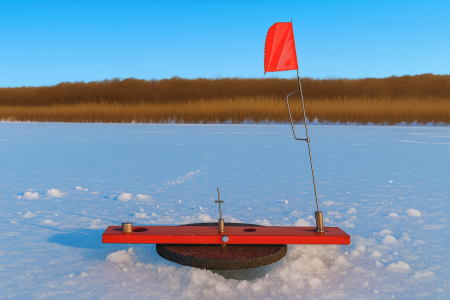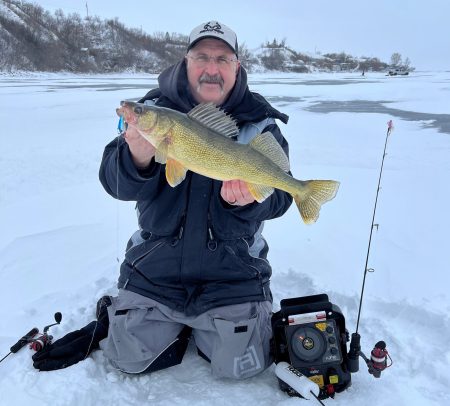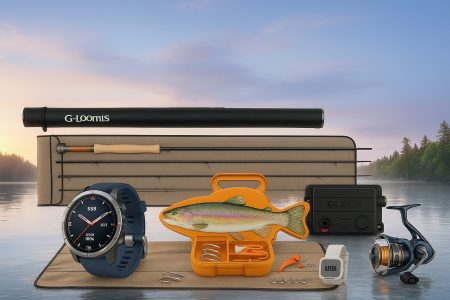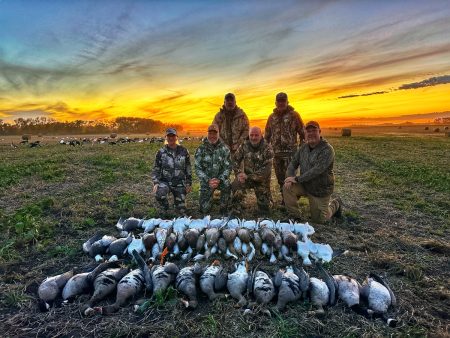Lake Texoma’s legendary striper fishing was everything we’d hoped for and more. Guided by the skilled hands of Dave Escamilla from Striper Express, we set out at dawn, eagerly anticipating the thrill of Texas-sized stripers tearing into our topwater plugs. With decades of local knowledge, Escamilla positioned us for success, delivering an unforgettable experience in one of North America’s best natural striped bass fisheries. From adrenaline-pumping topwater explosions to hooking hard-fighting brutes on live shad, this was a striper fishing adventure that lived up to its reputation. Striper Express guide David Escamilla, known in fishing circles as “Lil’ Dave, eased the throttle back on the big Falcon guide boat and pointed the bow toward a gently sloping shoreline about fifty yards away. Dave has decades of striper catching experience under his belt and has for several years guided for Striper Express Guide Service, owned by Bill Carey and his son Chris. I first began striper fishing with Striper Express almost 40 yards ago. I watched the newly founded company grow into the largest and one of the best striper fishing charters on Lake Texoma, situated about an hour north of Dallas on the Texas/Oklahoma border. Lake Texoma is one of the few striped bass fisheries in the country with a documented annual spawn. Thanks to salt domes about forty miles upstream of the lake on the Red River, the water has the ‘just right’ buoyancy to keep stripers’ eggs slowly bouncing along the bottom during the spring spawn, resulting in a natural spawn that keeps the giant reservoir well stocked with linesiders. True Timber graciously provided gear for our winners to be on the water with comfortable fishing gear appropriate for the season.
“I wish there were a little more wind, but our wind is from the south and will be concentrating bait against this north shore. I don’t expect we will catch a lot of fish on top waters because of the slack wind, but hopefully, we will connect with a few big fish that will stretch our line before we head out to put some fresh shad in the bait tank for some red hot live bait fishing.
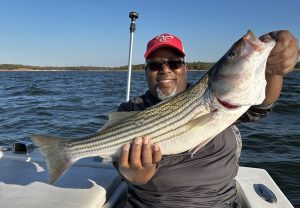
There is nothing like seeing a big striper blow up on your top water plug, not get hooked, and then come right back to devour the bait. It’s stuff fishing memories are made”, says Dave as he passes rods rigged with jumbo size top water plugs to Damien Antoine and I. The technique we were fishing is known as “blind casting,” and years of fishing experience and knowledge of the haunts of the big fish are key to success. Seldom does this technique produce large numbers of stripers, but it is a tried and true method of boating some line sizzling brutes during the first hour or so of daylight and even longer if there is cloud cover. This is a tried and true fall big fish pattern. When the cold weather sets, these same big rogue stripers can be landed on big jigs and soft plastic trailers.
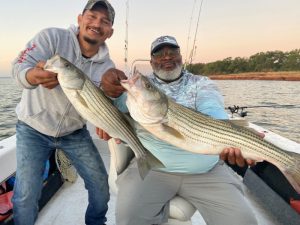
Damien’s brother Kyle from Douglasville, Georgia, had won a 2-day fishing trip for two with Striper Express through a drawing sponsored by North American Outdoorsman. Damien was held over at an airport with a flight delay on this first morning of fishing. Brother Damien represented the team well and when he hooked the biggest striper of the day on top water during the first few minutes of daylight, I knew another striper fisherman was ‘hooked’ on Texoma and the awesome striper fishing the lake offers.
As we began our first-morning cast, just as the sun appeared on the eastern horizon, there was absolutely no clue we were in a trophy striper hotspot. No birds were visible to lead the way to the action, and no stripers were breaking the surface chasing shad, just the ripples of water caused by a light south wind. “Cast as far out as you can and retrieve the bait like this”, Dave instructed as he made a long cast and jerked the top water plug hard a couple of times, which really churned up the water. He then cranked the reel quickly to take up the slack line and repeated the process. The erratic surface action mimics a baitfish on the surface and triggers the dinner bell for nearby stripers who hear it ringing! There is no tap-tap on the lure indicating a strike as when fishing sub surface. No, when a striper, especially a big one, decides to grab his breakfast on the surface, he does so with much gusto.
It’s not uncommon to see the plug fly a couple feet into the air on the stripers initial strike. The intention is to kill or cripple the baitfish and if the first attempt is not successful, a quick second strike is often the norm. The strike will also be accompanied with a slap of the fish’s tail in it’s attempt to stun its prey.
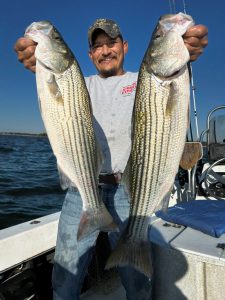
One of the most challenging things with top water fishing is to remain calm when you see that topwater explosion. One of two things will happen: the fish will hook itself with the force of its strike, or the force of the water being pushed ahead of the fast-moving fish will simply push the plug up and away from the fish’s mouth. If the line does not ‘load up’ and indicates there is a big fish pulling on the other end, it will go slack. Experienced anglers will let it set motionless for a few seconds in anticipation of the second strike when the striper is likely to inhale the bait. I believe this to be the most challenging aspect of fishing.
Adrenaline is pumping and the brain is saying, “Hey buddy, that fish just tried to steal my lure, it’s time to rear back on the rod and get it back. The striper has rendered its prey motionless with a savage strike and slap of its tail; it’s now time to return and chow down! Whether the hook-up comes on the initial strike or when the big striper returns to consume its prey, it’s important to have the reel’s drag set fairly light. If the drag is cranked down too tight, a big stripper is likely to either pull the hook out or break the line of that initial run when he feels the hook and heads for the other side of the lake.
The key to success is letting the bend of the rod and the reel’s drag system do its work to tire the fish. After several strong runs, if everything goes just right, the fish will still have enough strength for a last strong run, but you will hopefully have it boatside. Lots of fish are lost at this point due to a lack of experience using a landing net. Make sure and ‘use enough net’. These big stripers aren’t crappie or white bass, and they require a net at least 2 feet in diameter. Never, ever try to put the net behind a striper moving alongside the boat. He will have plenty of fight left and it’s a good bet he will try to outrun the net. Rather, place the net into the water ahead of the fish, and as it approaches, it will basically swim into the net.
This was Damien’s first time fishing for stripers, but he has caught lots of big redfish along the Louisiana coast and near his home. After landing the first striper of the morning, which turned out to be the big fish of the day, he commented that these line-sided brutes would give redfish a run for their money in the pulling department. That’s saying something! Big Bull Reds are known for their line-sizzling runs and brute strength.
Through the years, I have fished for striped bass in most of the top fisheries, but to date, I’ve found nothing that comes close to the dependable fishing at Lake Texoma, and I feel blessed to live within a short drive. I’ve been fishing these striper-rich waters several times a year for nearly 40 years, many of the trips with Bill Carey dating back 4 decades ago when he began his Striper Express Guide Service. My next trip is scheduled for December, when the fish will be on a good jig bite.
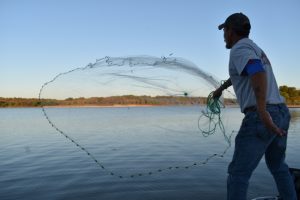
After catching a few jumbo-size stripers on top waters during the first hour or so after daybreak, Lil’ Dave motored to a shallow cove where the water was dimpled with baitfish (shad) breaking the surface. A couple of casts of his 7-foot cast net (which opens to 14 feet) produced a tank full of frisky shad, and I knew it was ‘game on’ for catching a limit of stripers under 20 inches in length. Texoma has the most liberal striper limit in the state, ten fish with 2 over 20 inches in length. We had our top water ‘big fish,” and now we were after the limits of what is known as box fish. I absolutely love blackened striper and had plans to put my cast iron skillet to work for an evening meal. Each fall, huge flocks of seagulls appear, and winter on the lake, feasting on the hapless shad that hungry stripers drive to the surface.
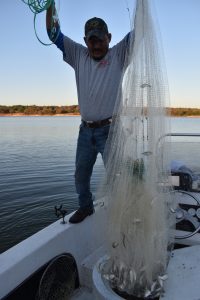
Using binoculars, Dave spotted a large flock of gulls diving and splashing the surface. Once the direction of the school of fish/birds was determined, the boat was positioned ahead, and soon, wave after wave of fish was showing up on the graph. Some were running a few feet up from the bottom, and others were suspended higher in the water column. As each school passed under the boat, Dave instructed how deep to drop our live shad. Catching was nonstop, and in less than an hour, we were making the way back to the harbor of Mill Creek Resort, headquarters for Striper Express.
Both of the Antoine brothers were highly impressed with not only this heralded striper fishery but Striper Express Guide service as well. Living close to the coast where catching bull reds (redfish) is the name of the game this time of year, they were impressed with the fight the stripers put up. “Just like big redfish, these stripers will fight you all the way to the boat. We’re both coming back and we will definitely be fishing with Striper Express”.
To book your trip with Striper Express, visit the website www.striperexpress.com. The top water bite usually begins in late spring and lasts until the fall. But fishing is awesome year around and the guides at Striper stay current with changing patterns.
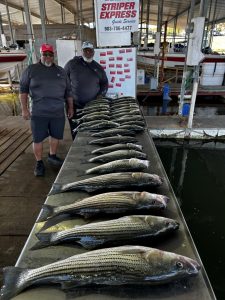
Listen to Luke’s radio show, which becomes a podcast each week, “Catfish Radio with Luke Clayton and Friends,” wherever you find your podcasts.
Thanks to our partner True Timber for providing gear to our winners:
- TrueTimber Osprey Hoodie
- TrueTimber Twin Reef Short
- TrueTimber Mesh Back Hat
- TrueTimber 15L Round Dry Bag
Read More about the action on Lake Texoma for Stripers: Lake Texoma: Queen of Inland Striper Fisheries
Smoked Fish Dip using Lake Texoma Stripers: Smoked Fish Dip
Per our affiliate disclosure, we may earn revenue from the products available on this page. To learn more about how we test gear, click here.







